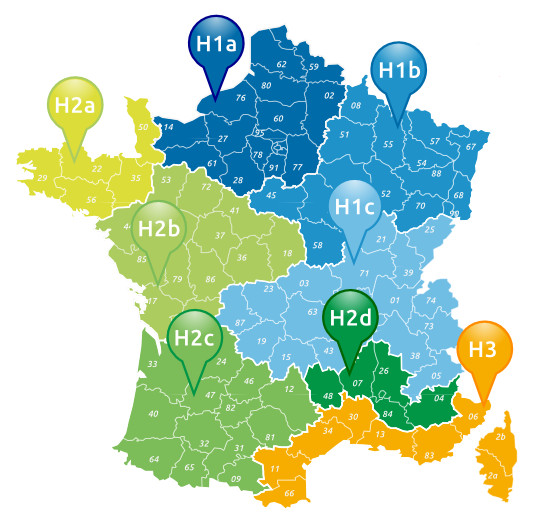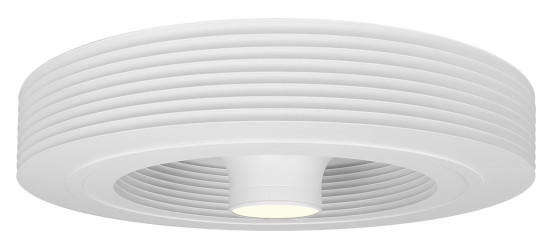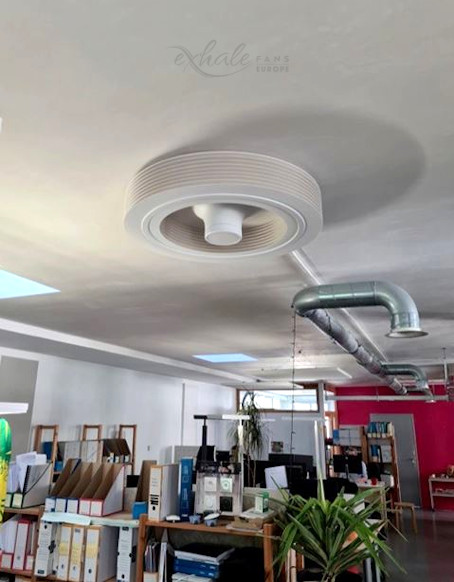Article updated on 28 September 2021
Air curtains and RE2020: a revolution in summer comfort
In June 2004, one year after the great heatwave of 2003, Thierry Salomon’s “Fraîcheur sans clim” was released.
This book is based on both sound science and good practice from local and international traditions. The air blower is then presented as one of the most obvious, economical and environmentally friendly solutions for dealing with the summer heat.
Thierry Salomon, energy engineer and founder of Négawatt, can say that he was way ahead of the game.
It is true that the issue of summer comfort has been taken into account since the RT 2000 (thermal regulations introduced the same year).
The experimentation materialised by the energy-carbon label since November 2016 had allowed for the first appearance of air fans as such.
However, it is only in the context of the RE2020 (new environmental regulation applicable to new buildings, from the beginning of 2022) that ceiling fans really find their place in the official regulatory guidelines.
Below we propose to discuss the issue of ceiling fans / air movers in relation to the RE2020.
In a forthcoming article, we will highlight what is not yet taken into account, and what should be.
We’ll be talking about energy gains, destratification… Remember to follow us on LinkedIn, so you’ll be among the first to know when this new original content is released.
RE2020 and air movers: summer comfort as a goal
Air velocity, mixing ratio and thermal comfort
Architecture and Urban Planning Agency
263 Corniche Kennedy, Marseille
Premises equipped with Air Exhale Fans
www.vezzoni-associes.com
In our publication « Brasseurs d’air et confort d’été : le retour en grâce », we remind you that the increase in air speed significantly improves the feeling of thermal comfort during the summer season.
In RE2020, the air velocity is calculated from the hourly circulation rate. This is the number of times the air volume in a room is changed per hour, for example 75 volumes per hour. With one nuance: in the case of air mixers, it is clearly not a question of fresh air volumes.
To calculate the circulation rate, you need the hourly airflow in m3 of the fan, which is simply divided by the volume of the room.
Test protocols and certification: virtual bonuses for the moment
Pouget Consultants Paris
81 Rue Marcadet, 75018 Paris
www.pouget-consultants.eu
On the justification side, it is possible to refer to the standard NF EN IEC 60879, which defines the measurement conditions for air movers. However, this standard does not seem to be widely known, and there are questions about its relevance. For example, air velocities are measured with propeller anemometers, which may be accurate, but are ill-suited to omnidirectional air flows.
As far as certification is concerned, we do not know of any solution applicable in France.
Moreover, even if certification were possible, it is an expensive process. For a single appliance, the annual budget for obtaining and maintaining this recognition is in the range of 15 to 30 k€. For ceiling fans, which have a unit cost that generates low margins, such an approach seems risky. It is therefore likely that very few appliances will be certified.
Test protocols and certification: virtual bonuses for the moment
Compared to the data provided by the manufacturer, the hourly flow rate is increased by 10% if the device is justified on the basis of measurements in accordance with a standard, and by 20% if it is certified by an approved organization.
On the justification side, it is possible to refer to the standard NF EN IEC 60879, which defines the measurement conditions for air movers. However, this standard does not seem to be widely known, and there are questions about its relevance. For example, air velocities are measured with propeller anemometers, which may be accurate, but are ill-suited to omnidirectional air flows.
As far as certification is concerned, we do not know of any solution applicable in France.
Moreover, even if certification were possible, it is an expensive process. For a single appliance, the annual budget for obtaining and maintaining this recognition is in the range of 15 to 30 k€. For ceiling fans, which have a unit cost that generates low margins, such an approach seems risky. It is therefore likely that very few appliances will be certified.
What is the maximum area that can be served by a ceiling fan?
The value used is 15 m². This approach is perfectly suited to rooms, but may in some cases lead to oversizing.
In fact, for a room of 50 m², 4 fans are needed to meet this requirement.
What is the maximum ceiling height?
For air movers to have an impact on summer comfort in the RE2020, a maximum ceiling height of 3m must be respected in the rooms concerned.
A minimum height under the rotating system (blades or structure) is not specified. As a reminder, the thermal and acoustic regulations of the DOM (RTAA DOM) include the notion of a minimum height under the blades of 2.30m to install air fans.
For its part, the RTG 2020 (Thermal Regulations of Guadeloupe) is more explicit. It mentions that “it is recommended to respect the height under the blades given in the IEC 60335-2-80 standard, i.e. at least 2.30 m”.
The impact of air movers on electricity consumption is taken into account in the overall energy balance
This is quite logical: the more energy an air curtain consumes, the more it impacts the overall balance of the building. And naturally, the heat released by the operation of the device is taken into account in the calculation of summer comfort.
As with the hourly air flow rate, the electrical power of the air curtain can be increased compared to a standard unit, if the fan is justified (+10%) or certified (+20%). With the nuances mentioned above…
A bonus is provided for air ceiling fans equipped with thermostats, allowing the speed to be increased according to the temperature
The regulations provide for several modes of operation for ceiling fans: manual, automatic speed control with thermostats or fully automatic speed control. For all intents and purposes, “fully automatic speed control” means that the operation of the fan does not allow for adjustment by the user, unlike the other two modes.
In itself, the principle seems judicious: when the temperature rises, the speed of rotation is adapted to provide better thermal comfort.
However, at present, few air movers are equipped with thermostats. Thus, the regulations could encourage the development of this type of improvement.
Carbon footprint: only one generic sheet available
When the RE2020 starts early next year, it will probably have to make do with the only available Product Environmental Profile (PEP) sheet, which shows 136 kg of CO2 over the entire life cycle.
Seven times less greenhouse gas impact than a standard electric convector: it should be possible to do better with a more specific analysis.
Ceiling fans and RE2020: very good news for the environment
The inclusion of air movers in the regulations for the construction of new buildings is therefore progress, an achievement that should be welcomed.
Ceiling fans are easy to install, economical to buy and to use. They also have a low carbon footprint.
Let’s join the movement, and make air movers commonplace in efficient buildings!

In Zone H3/H2D (Mediterranean arc), air mixers are essential for summer comfort in order to meet the requirements of the RE2020.
Did you like this deciphering? Follow the link to the next article. You will find the beneficial impacts of air blowers absent in the RE2020.

Exhale the first vortex ceiling fan without blades
Are you a professional? We have dedicated a specific space to you.
Find Exhale Fans Europe on Linkedin



